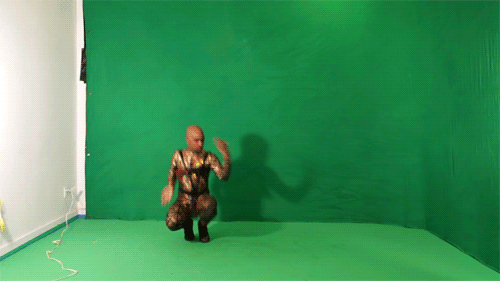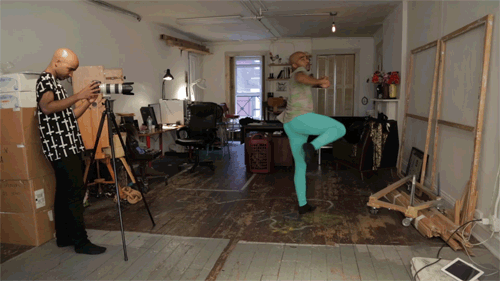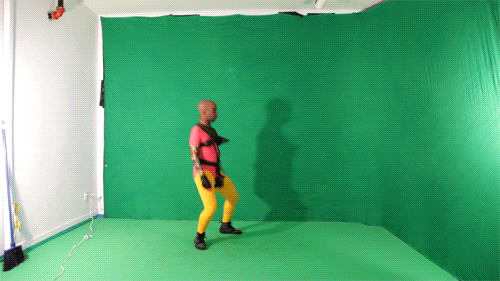
On Trusting Your Process
From a conversation with T. Cole Rachel
October 14, 2019
Visual artist Jacolby Satterwhite on recognizing the patterns and repetitions that filter through your own work, the ways in which deep collaboration can activate your thinking, and not losing sight of the present moment, even in the midst of chaos.
Your body of work encompasses so many different kinds of materials and practices. What does the landscape of your creative life typically look like?
I don’t have a regular creative life. I have a twisted life, if anything. I feel like I’ve been married to my 40 gigabyte stack of hard drives for the past five years that I’ve had this current computer, but really it’s been about 10 years of working in this physically laborious digital way. It’s kind of like an experimental form of architecture where I am collecting images and archiving drawings and sound pieces and basically metastasizing data that is scattered throughout my hard drives and all throughout my bedroom and my studio. I massage and marinate those ideas until they find form through 3D animation or some kind of virtual reality piece.
Usually the 3D animation stuff will be scored by an album that I also made, and is attached to the piece because they are rooted in a similar space, and are negotiating similar processes. They are all contingent on each other’s success. One thing can’t really go without the other. I am very interdisciplinary, but it sometimes comes off as being all over the place. But technically it’s just kind of an extended frame sculpture, something that goes beyond the medium, but where the central idea is the nucleus.
As for right now, lately I’ve been working at the fabric museum with assistants for the first time and I’m finishing up pieces for my Pioneer Works show. My work has expanded from both of those collaborations significantly, which has liberated me to also push back into a more literal painting practice.
I guess I’m just saying that I have these core ideas I want to explore, which form the nucleus of the work, and all the various atoms that orbit that are just parts of whatever is necessary.
It’s like they all exist in this universe together. Has it always been that way for you?
Yeah. I’ve been making art since I was a kid. When I was a kid, my bedroom was my escape from a chaotic home. I guess when you are suspended in such chaos, you find ways to stay out of it. I was an extreme, avid gamer, and like a lot of adolescents, I was playing games all day. When I was 11 years old, I developed cancer and had to stay in the hospital for nearly two years, and one way that I kind of evaded the problem was to play Final Fantasy and Tomb Raider and Metal Gear Style and beat them over and over again, both in the hospital and at home. I feel like when you reroute your traumas to a neutral place, usually those devices become something to you. They imprint on the aesthetics of your brain because that’s what your brain relies on to feel at ease. That’s why when I was a kid I wanted to be a game developer. I was always asking my dad to buy me coding books so I could do research. I wanted to move to Japan and work for SquareSoft. Then I ended up getting more into my painting practice and went on to study that, but during graduate school I basically stopped. I put down the brush.
I’m the kind of person who has synesthesia with certain ideas. Curiosity is an infection and you really just have to massage the boil until you can lance it and figure out what is at the core of this obsession. In my practice I have obsessions with things, like certain art historical compositions, Caravaggio’s “Doubting Thomas” for example, which I’ve kind of articulated in my work in different drawings and sketches and paintings ever since I was a teenager.
During that period of time when I had cancer, I really relied on art making and art processes and gaming as way to kind of channel my energies in order to survive. Afterwards, I think I was just traumatized. I was thinking about my own mortality, so I was making marks in order to leave something behind to prove that I am real. And it was an interesting way of thinking about process and art making.
I think every artist, on some level, makes work as a way of doing that. Any kind of ritualistic process is a form of journaling and reminding yourself that you’re present; it’s about maintaining some sense of mindfulness, of presence. A lot of my work that has that kind of reoccurring motif—as if you make a mistake with how you form the shape, how you execute something, and then you start over and try again and try again and try again until the composition reveals itself, you know. What I’m trying to say is that I guess that is the reason why my practice warrants itself to be so… diverse? Yeah.
You are a dedicated collaborator as well. You have the PAT project coming up, with Nick Weiss, and you had a very celebrated collaboration recently with Solange. Are collaborations a way to sort of shake you out of your normal process and patterns of working?
No, not really, because I’m very fluid and organic with how I develop things. So anytime I work with another person, they usually bring out sensibilities in me that were dormant, but needed to be activated just by being in an unfamiliar space. So in a way, working with other people keeps things fresh. It allows me to see things a little bit differently and spin things on their head a bit differently. When I was working with Solange and we had our creative meetings, she was focused on the black rodeo and this idea of finding home.
It got me thinking that way as well. I was always obsessed with the Saturn return idea—the age between 27 and 32, where basically you enter a certain kind of space of criticality where life can be super challenging, but it allows you to figure out who your true self is. I also have a lot of references to home in my own work, so one thing that was really interesting about collaborating in that way was that in a way we both had similar issues. There are formulas that think about the geometry of space and light and textures and the way that they align with our own personal metaphors, our own personal mythologies. And she was centering her frame line, her obsession with the black rodeo culture in the South. We’re both from the South, but I feel like she had more experience with that than I did.
One thing that opened up in me through that collaboration was that I started to think about architectural forms that relate to spectatorship, like coliseums and circular forms where people come together to experience a specific central thing. And the reason why I was interested in that was because the circle kind of emulates the 360 aspect that happens in virtual reality. A project like that allowed me to focus on things that I normally don’t focus on as much, like architecture and working in a 360 frame.

Nick is wonderful to work with because he and I have a very similar taste in music. I wanted to invest 100% into doing a music project around my mother’s cassette tape recordings, which is also conceptually collaborative. For me it’s like playing exquisite corpse and a surrealist game with chance and trying to find harmony with two separate heads coming together. It’s a great way to create friction for creative growth.
That’s why I believe in collaboration so much, and that’s why, when I’m working on casting for films, I’ll basically take anyone on set with me and put them on the green screen. That’s why I used to carry a green screen in my backpack and go to Fire Island or to Los Angeles or to the standard hotel, and do pop-up events where I’m really just taking the chance with who may be orbiting the space at the time. Usually it’s within the queer community, because that’s the easiest place to access interesting people and do such things.
And that’s a form of collaboration, too. It’s a crystallized and brief collaboration where I’ll have someone on my stage for five minutes doing a very banal labor gesture, because I’m obsessed with that kind of choreography, and then I take that back to my studio. It’s like collecting information on a camera. Everything is just data. You are building up this body of data, and it’s a way of dealing with things that I’m unfamiliar with. It’s a way I can grow and expand.
What typically gets in the way of your creative work?
I mean, I’m very transparent. What’s getting in my way: not having a therapist.
How so?
I don’t know. I think that the amount of work I have to do to maintain what I do, it’s really tight. It involves a lot of my time, and takes time to reflect on. I think that having such a sincere commitment to my conceptual practice, it definitely can get in the way of thinking realistically. I’m always thinking conceptually. I’m committed to the work all day, every day, even when I’m not with the work. Even if I’m at a bar or something, I’m still working, still gathering things. So I feel like there’s sometimes a lack of balance in my life, which comes with having such an intense schedule around my creative practice.
Just to give you an idea—I’m doing two museum and institutional solo shows at the exact same time, opening two weeks apart. One of them is two entire floors. Sometimes it’s just this nonstop pipeline of trying to execute lots of things simultaneously. It’s a vulnerable thing and it can be very taxing on you psychologically, so that’s why I say finding a sense of mindfulness is very important… and I think that’s something I lack.
How do you avoid going crazy doing so many things at once?
You think that I’m not crazy? [Laughs] I think so far, it’s always been about self-care and meditation. I do invest a lot in trying to be as healthy as possible, but sometimes you do lose your mind. But you live and you learn.
This is a very hard thing for a lot of people. When these big opportunities come there is often this feeling like you can’t really say no, but it’s very hard to maintain that and not lose yourself in the process.
I don’t feel I have anxiety about saying no. I definitely feel like I can say no now. I guess what I’m trying to say is that I’ve definitely grown to be more decisive.
Do you have any advice for young artists? Anything you wish you’d known when you were just starting out?
Usually I love this question. Usually I would have the right answer, but lately I’m realizing that there is a kind of circularity in my own patterns of behavior. Sometimes I don’t take my own advice, and I sink back into previous habits that weren’t necessarily helping me get to where I need to be. I can be super aware of it, but then I’ll just do it anyway.
I don’t know if that sounds vague, but I feel like I find myself being hypocritical about these lessons. So I feel less compelled to give lessons anymore. One thing that I take pride in, though, is that I did things my own way when I was young, and I’m still doing things my way now. There were people who were skeptical about my strategies for how I like to deliver my vision, but now those strategies are working for me in the extreme. So, I’d say follow your instincts, but also know that you might slip back into things that were preventable if you aren’t careful.
I think a lot of people also are chasing this horizon line where they feel like, well, if I can just get to this place, or if this one thing will happen, then I’ll feel good.
But then it gets you into this place where the future always exists, but you never understand the present. If you don’t acknowledge the present, you can never acknowledge the future. You start to fantasize about this clear space that resides in the future, without realizing that you’re already in that clear space. I don’t know how to articulate that advice, but that’s the one that I’m trying to give. Don’t get so caught up in the future that you can’t see where you are right now.

Some Things
Jacolby Satterwhite Recommends:
I’m kind of obsessed with people. I’m obsessed with social media figures who are doing this Warhol, Joseph Beuys kind of narrativizing of their own lives in such a way that their lives feel like objects in a grid. That kind of personal branding is so fascinating to me. I guess what’s inspiring to me is how it’s becoming so sculptural. I feel like the ordinary person is learning a kind of sculpture practice without knowing it, because it’s also just capitalism now. It’s like what was formerly known as the core format interdisciplinary practice is now just what it means to become an influencer. So I’m interested in that blurred line that’s happening between certain kinds of practices that were taught in school when you were studying performance theory or 70s conceptual practices. Those same performative ideas are reaching down to the everyday masses, for people who want to become an influencer on the internet. So many things in art seem to have anticipated this moment. There could be a show about this, about how all of these different key practices in modern art almost predate and anticipate what every fucking human being is trying to do now.